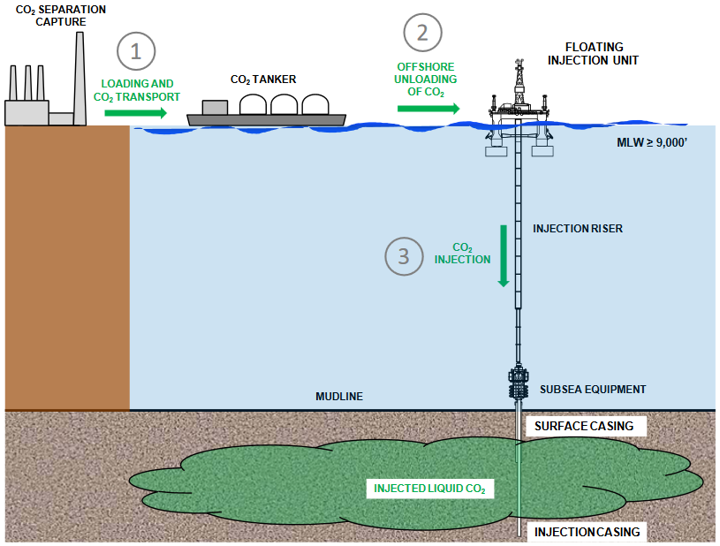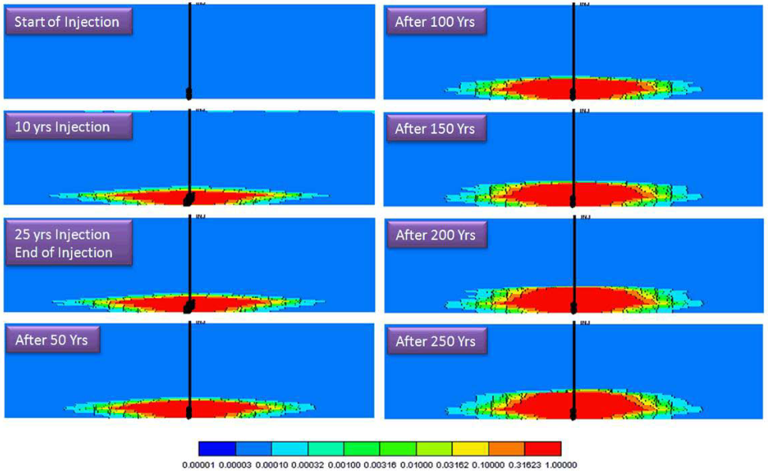Carbon Capture and Sequestration
Since 2008, Blade has been involved in CCS projects, across a range of engineering activities. Blade has also made fundamental contributions to engineering and analysis for CCS projects, and has published several papers in this area.
Blade’s multidisciplinary expertise and extensive experience with conventional carbon dioxide (CO2) flooding, and gas storage projects make us the partner-of-choice in engineering carbon capture and sequestration (CCS) projects.
Blade also recently presented a paper at the DEA meeting in Cambridge, England, on December 1, 2022 (see Ceyhan, I., “Engineering Process for Designing Carbon Capture and Sequestration (CCS) Wells”). The paper describes the multidisciplinary FEED process for CCS projects, illustrating key result in each step of the process. It provides a useful reference for companies contemplating or developing large scale CCS projects.
Blade is happy to announce that we now have a customized storage security and leak risk assessment program. Building on the base of the NRAP-IAM-CS open program, we have customized the input/output, made the program inputs more flexible, enabled storage complex inputs based on reservoir simulation results, and are in the process of building customized Reduced Order Models that allow consideration of depleted hydrocarbon thief zones, and inclusion of statistical cement quality data. Blade is using this program to provide a crucial service to the growing CCS industry – assessing the risk of leaks from existing and legacy wells, obtaining stochastic leak estimates, and selecting legacy abandoned wells for corrective action or additional monitoring.
Blade CCS Expertise
Blade offers the following areas of expertise in CCS.
PVT characterization and thermal/flow modeling specific to sequestered gas composition.
Migration modeling, zone selection and storage design.
Reservoir geochemistry, modeling CO2-water-mineral interactions.
Thermal analysis and well design specifics to CCS wells and tubulars.
Design and analysis of advanced cements.
Design for well integrity management over CCS life cycle.
Material selection for wells and facilities for CCUS life cycle performance.
Design and analysis of anisotropic materials often used in CCS wells.
Field development planning for large-scale projects to ensure attractive economics over CCS life cycle

Blade CCS Experience
Blade has extensive experience in engineering for CCS projects. Some of our past experience in this area includes:
- Injection for a sequestration project in Canada
- Collaboration with Petroleum Experts to improve CO2 modeling (pure and impure) using PROSPER software
- Validation of new models for a Mississippi project using static and flowing gradient surveys in near-pure CO2 producers
- PVT characterization and injection modeling for a CO2-methane-helium producer in Wyoming
- CO2 production field optimization, involving interaction of networked wells
- CO2 pipeline modeling with impurities to resolve slugging problems
- CO2 injection and production well modeling for CO2 floods of oil fields (with circulated impure CO2)
- Well design, field development planning, and techno-economic analysis for a project to sequester CO2 from a power plant in Texas

Blade CCS Publications
Listed below are Blade publications relevant to Carbon Storage. Abstracts are included for your reference. Please do not hesitate to contact us if you wish to discuss any of the topics in these papers.
Pilisi, N., Ceyhan, I., & Vasantharajan, S. (2010) “CO2 Sequestration in Deepwater Subseabed Formations.” SPE Paper 139498. https://doi.org/10.2118/139498-MS
Abstract
Recent studies have estimated that oceans have naturally sequestrated, by dissolving and mixing with deep waters, about 40% of the anthropogenic CO2 emitted since the start of the industrial revolution. Moreover, the International Maritime Organization has recently announced that storage of CO2 under the seabed would be allowed starting in 2007. To date, almost all studies, simulations and technical papers concerning carbon sequestration have focused on storing supercritical CO2 in deep saline aquifers or depleted oil and gas reservoirs. However, a critical limiting factor for such carbon sequestration is the need for proper physical trapping and the necessity for monitoring the upward migration due to buoyancy effects and mobility of supercritical CO2. Carbon sequestration in deepwater sub-seabed formations provides an attractive alternative.
This paper presents a feasibility study of carbon sequestration in deepwater formations in the Gulf of Mexico with the existing technologies available in the offshore industry. We describe each step of the carbon capture and storage process and discuss the technical limitations when trying to capture CO2 from industrial processes, transport it offshore via tanker, drill a CO2 injector well and then, inject the CO2 from floating facilities such as drill ships or semi-submersible vessels. Due to high pressures and low temperatures reigning at water depths deeper than 9,000 feet, the liquid CO2 injected in the first few hundred feet of deposits will have a higher density than the surrounding formation pore-fluid and therefore will be buoyantly trapped. In addition, CO2 hydrates that may form and fill up pore spaces will act as an additional trapping mechanism. Finally, at these great depths, the CO2 that could leak will dissolve by reacting with ocean waters and forming mainly bicarbonate compounds.
Because oceans cover about 70% of the Earth’s surface with an average water depth of 12,500 feet, deepwater sub-seabed sequestration provides an enormous storage capacity to counteract increasing world consumption of fossil fuels. However, large time and space-scale simulations need to be performed to estimate the impact of the change in geochemistry in the deepwater seabed region. Also, the injection of liquid CO2 will force and displace formation fluid into the seabed surface zone, which will change the ocean chemistry.
Ceyhan, I., Santra, A. K., & Cullick, A. S. (2011). “Carbon Dioxide, Geochemical, and Rate-of-Dissolution Simulation for Deep Storage Environments.” SPE Paper 141031. https://doi.org/10.2118/141031-MS
Abstract
Permanent underground storage of carbon dioxide (CO2) has been proposed as a potential mitigator for greenhouse gases in the atmosphere. In such underground reservoirs, CO2 is trapped through a complex combination of physical and chemical processes. Also, injected CO2 in contact with subsurface water can decrease the cement strength, deteriorating wellbore integrity. Current industry programs, such as reservoir simulators and wellbore-cementing programs, provide powerful models for the physical processes. This paper discusses a model for the remaining geochemical processes. This model is designed for implementation in existing industry programs, enabling the industry, while planning carbon capture and sequestration (CCS) projects, to take advantage of experience acquired throughout many years.
A self-contained solution procedure has been developed to solve geochemical equilibrium calculations. The equilibrium within the brine phase is computed with activity coefficients calculated by use of either the general Helgeson-Kirkham-Flowers (HKF) electrolyte model, or the more-accurate Pitzer ion model. A correlation from open literature has been selected to calculate the equilibrium between CO2 and brine phases. Once equilibrium is established, the model calculates precipitation or dissolution rates for common minerals. The solution procedure has been designed for optimum balance between robustness and calculation speed while solving the nonlinear geochemical equilibrium problem. A novel initialization scheme and a three-pass solution procedure are introduced. During Pass 1, activity coefficients are set to unity while a nonlinear minimization algorithm is used to locate the neighborhood of the equilibrium solution; in Pass 2, the first pass is repeated with the activity coefficients being calculated by use of the selected model. Finally, during the final pass, the solution is refined to the desired accuracy by the use of a nonlinear solver.
The solution model fits observed data. The CO2 solubility and brine phase pH can be computed for temperatures between 300K (80°F) and 478K (400°F), pressures up to 414 bar (6,000 psia), and brine strengths up to 6 mol NaCl/kg H2O. The more than 50 primary and secondary mineral species in the database represent common carbonate and clastic formation components. Temperature-dependent dissolution and mineralization rates can be predicted at similar conditions.
As the industry plans CCS projects, it must document projections of formation and well integrity during the project lifetime. The solution procedure is suitable for inclusion in various oil and gas industry models, including cementing simulators or reservoir simulators, to model CCS in subsurface aquifers and enhanced oil recovery (EOR). This paper provides guidance on how the algorithms should be implemented within reservoir simulators.
Pilisi, N., & Ghorbani, D. (2012) “CO2 Sequestration Studies in Ocean and Deep Sea Sub-seabed Formations.” AAPG Search & Discovery Article 70119.
Pilisi, N., & Ghorbani, D. (2012) “Optimization Under Uncertainties for CO2 Sequestration in Deepwater Sediments.” AAPG Search & Discovery Article 90142.
Pilisi, N., & Ghorbani, D. (2012) “Viability of CO2 Injection and Storage in Deepwater Subseabed Formations: Case Studies.” Carbon Management Technology Conference (CMTC) Paper 151393. https://doi.org/10.7122/151393-MS.
Abstract
Because supercritical CO2, when injected onshore or in shallow water depths offshore, is mobile and can, therefore, migrate through any conduits or fractures, there is a need for proper physical trapping and also a necessity to monitor the CO2 migration in the injected zone. In addition, public opinion, government regulatory agencies and the lack of space for CO2 injection sites in some of the largest CO2 emitting regions of the world encourage investigating other alternatives such as CO2 sequestration in deepwater sub-seabed formations.
Furthermore, at the high pressures and low temperatures reigning in deepwater sediments where water depths are greater than 9,000 feet (˜2,750 meters), scientists have proposed that the CO2 should become denser than seawater and therefore would remain buoyantly trapped when liquid CO2 is injected within the first few hundred feet of sediments even in the absence of geological seals and traps. Besides, the bulk of the studies and technical papers concerning CO2 sequestration in deepwater sediments have focused on showing the potential and the feasibility of the concept but very little has been published to demonstrate the viability of the injection and long-term storage of CO2 in deepwater sub-seabed formations.
This paper presents the results of several case studies located in the Gulf of Mexico, the Pacific Ocean, the North Atlantic Ocean and the Sea of Japan. Large time-scale reservoir simulations have been conducted for up to 250 years and show that injected liquid CO2 can remain trapped in deepwater sediments under certain sediment physical properties. Therefore, CO2 sequestration in deepwater sediments provide another attractive technical solution when applied under certain conditions of pressure, temperature, sediment type, thickness, permeability and porosity notably for regions where there are few depleted oil and gas fields available for storage or limited space accessible onshore.
Ghorbani, D., Pilisi, N., & Vasantharajan, S. (2012) “CO2 Sequestration in Deepwater Sediments: Optimization and Parametric Studies.” Carbon Management Technology Conference (CMTC) Paper 151396. https://doi.org/10.7122/151396-MS.
Abstract
CO2 injection and storage in deepwater sediments under water depths greater than 9,000 feet (˜2,750 meters) where high pressures and low temperatures result in the CO2 being denser than seawater and therefore being buoyantly trapped in the sediments pore-fluid, could provide an attractive sequestration option for countries and regions densely populated and emitting large quantities of anthropogenic CO2 such as East and West Coasts of the United States of America, Japan, the East Coast of China and Western Europe. In these places, public opinion, government regulatory agencies, a lack of space for CO2 injection sites and few depleted oil and gas fields available necessitate the application of alternative technologies to sequester CO2 in order to mitigate a significant part of the 30 billion tons of CO2 annually released in the Earth’s atmosphere.
This paper presents the results of multiple reservoir simulations and parametric studies for different types of deepwater sediments located in various regions of the globe (Pacific Ocean, Atlantic Ocean, Japan Sea and Gulf of Mexico). Since not all regions and sediments deposited below 9,000 feet of ocean waters seem to be viable to permanently store CO2, this study focuses on the critical parameters that need to be considered to successfully inject and permanently store liquid CO2 in deepwater sub-seabed sediments.
In fact, when injecting liquid CO2 through an ultra-deepwater conduit (injection pressurized riser) within the first few hundreds of sediments, several uncertain variables such as temperature, sediment type, sediment thickness, permeability, porosity and CO2 injectability greatly influence the overall integrity of the buoyant trap. Very long-time reservoir simulations (e.g. 250 years) have been used to assess the effects of different decision and uncertain variables on the behavior and the evolution of the CO2 plume within the sediments. Also, experimental design and response surface methodologies have been used to quantify the risk associated with each of the critical parameters and to determine the optimal conditions for deepwater sediments CO2 storage. Finally, the essential findings of the paper provide the offshore and carbon sequestration industries with a high-level mapping of the world’s oceans and deep seas best candidates for CO2 storage in deepwater sediments.
Pilisi, N., Ghorbani, D., & Vasantharajan, S. (2012) “CO2 Sequestration in Deepwater Sediments Offshore Japan.” Carbon Management Technology Conference (CMTC) Paper 151756. https://doi.org/10.7122/151756-MS.
Abstract
When injected in deep saline aquifers or depleted oil and gas reservoirs, supercritical CO2 remains mobile and can, therefore, migrate through any conduits or fractures. In addition, public opinion, regulations and the lack of space for CO2 injection in some densely populated regions of the world such as the Japanese archipelago encourage investigating other alternatives such as carbon dioxide sequestration in deepwater sub-seabed formations.
This paper intends to present a technical feasibility study of CO2 sequestration in deepwater sediments offshore Japan. The main processes, technical requirements, technologies and structures that are currently available to transport and inject liquid CO2 successfully in sub-seabed formations below 9,000 feet of water (˜2,750 meters) are first discussed. Then, three storage sites situated offshore Japan; one located in the Northwest Pacific Ocean near the island of Shikoku; another located in the Sea of Japan near the island of Honshu; and the last one located farther in the Northwest Pacific Ocean in ultra-deepwater (18,000 feet); are selected to conduct reservoir simulations.
From this study, it appears that CO2 capturing technologies and transporting means seem to be at a mature stage. Also, current and newest 5th and 6th generation drilling vessels are estimated to be capable of drilling very shallow wells in water depths greater than 9,000 feet and even in ocean waters as deep as 18,000 feet if new materials such as titanium or composite for riser systems were to be deployed for both the drilling and CO2 injection operations. However, CO2 storing and injection facilities are not available yet to unload large quantities of CO2 offshore. As a result, some concepts should be designed, qualified and tested for these large scale operations within the next decade to demonstrate through pilot projects the technical feasibility of CO2 sequestration in sub-seabed geological formations.
Additionally, the main findings from this comparative study and reservoir simulations conducted at three different sites located offshore Japan confirm that a significant part of ultra-deepwater regions with at least 9,000 feet of ocean water and planar seafloor are appropriate for CO2 storage. Secondly, reservoir models confirm that due to high pressures and low temperatures reigning at water depths greater than 9,000 feet, the liquid CO2 injected in the first few hundred feet of sediments has a higher density than the surrounding formation pore-fluid and therefore remains buoyantly trapped under certain condition of geothermal gradient, sediments permeability and formation pressure and; hence constitute a valid and safe CO2 storage candidate.
Sathuvalli, U. B., Suryanarayana, P. V., Rahman, S., & Chandrasekhar, S. (2018) “The Triaxial Limit and Safety Factor of an Anisotropic CRA Tubular.” SPE Paper 191032. https://doi.org/10.2118/191032-MS.
Abstract
Tubulars made with Corrosion Resistant Alloys (CRA) exhibit a moderate degree of transverse anisotropy. This results in a lower yield strength in the plane perpendicular to the rolling axis of the tubular. In addition, cold work during mill finishing introduces yield strength asymmetry along the axis.
The majority of CRA tubulars are low do/t (~ 10 to 15) production strings and their design is usually driven by pressure and tension. Given the reduced yield strength in the hoop direction (as compared to axial yield strength), a rigorous method to assess the effect of yield strength anisotropy on the triaxial limits of the pipe is needed. Though there is a substantial body of mature literature on anisotropy in metals and manufactured composites, anisotropy of tubulars has received little attention by tubular designers.
In this context, we use Hill’s celebrated criterion (Hill 1950) for the yielding of anisotropic metals to develop an equation for the triaxial limits of a hollow cylinder and show that the currently used isotropic triaxial ellipse is a special case of the general limit. Also, by recognizing that purely elastic load excursions do not alter the yield surface, we extend the aforementioned triaxial limit to tubulars with tension-compression asymmetry along the tube axis. Finally, based on the notion of a strength utilization factor, we propose a method to determine the triaxial safety factor for anisotropic CRA tubulars. This method is consistent with the definition of the triaxial safety factor for isotropic tubulars.












